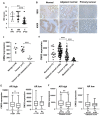Sex Hormone-regulated CMG2 Is Involved in Breast and Prostate Cancer Progression
- PMID: 36316045
- PMCID: PMC9620450
- DOI: 10.21873/cgp.20353
Sex Hormone-regulated CMG2 Is Involved in Breast and Prostate Cancer Progression
Abstract
Background/aim: Capillary morphogenesis gene 2 (CMG2) is involved in prostate and breast cancer progression. This study aimed to investigate sex hormone receptor-mediated regulation of CMG2 in breast and prostate cancer, and its implication in disease progression.
Materials and methods: Expression of CMG2, oestrogen receptor (ER) and androgen receptor (AR) was determined in breast and prostate cancer cell lines, respectively, using real-time quantitative PCR (QPCR) and western blot. Association between CMG2 and sex hormone receptors was analysed in a number of transcriptome datasets. Immunochemical staining was performed in tissue microarrays of breast cancer (BR1505D) and prostate cancer (PR8011A). CMG2 expression was determined in 17β-oestradiol treated breast cancer cells and AR over-expressing prostate cancer cells.
Results: CMG2 was found to be inversely correlated with sex hormone receptors in breast and prostate cancer. Lower expression of CMG2 was associated with a poor prognosis in ER (+) breast cancer but not ER (-) tumours. Both ER (+) breast cancer cell lines and AR (+) prostate cancer cell lines presented lower expression of CMG2, which was increased following sex hormone deprivation. Exposure to 17-β-oestradiol and AR over-expression repressed CMG2 expression in breast cancer and prostate cancer cell lines, respectively.
Conclusion: CMG2 is inversely correlated with ER and AR status in breast and prostate cancer, respectively. ER and AR mediate repression of CMG2 expression in corresponding cancerous cells.
Keywords: AR; CMG2; ER; breast cancer; prostate cancer.
Copyright © 2022, International Institute of Anticancer Research (Dr. George J. Delinasios), All rights reserved.
Conflict of interest statement
The Authors have no conflicts of interest to declare in relation to this study.
Figures




References
-
- Martinez de Dueñas E, Ochoa Aranda E, Blancas Lopez-Barajas I, Ferrer Magdalena T, Bandrés Moya F, Chicharro García LM, Gómez Capilla JA, Zafra Ceres M, de Haro T, Romero Llorens R, Ferrer Albiach C, Ferriols Lisart R, Chover Lara D, López Rodríguez A, Munárriz Ferrandis J, Olmos Antón S. Adjusting the dose of tamoxifen in patients with early breast cancer and CYP2D6 poor metabolizer phenotype. Breast. 2014;23(4):400–406. doi: 10.1016/j.breast.2014.02.008. - DOI - PubMed
MeSH terms
Substances
LinkOut - more resources
Full Text Sources
Medical
Molecular Biology Databases
Research Materials
